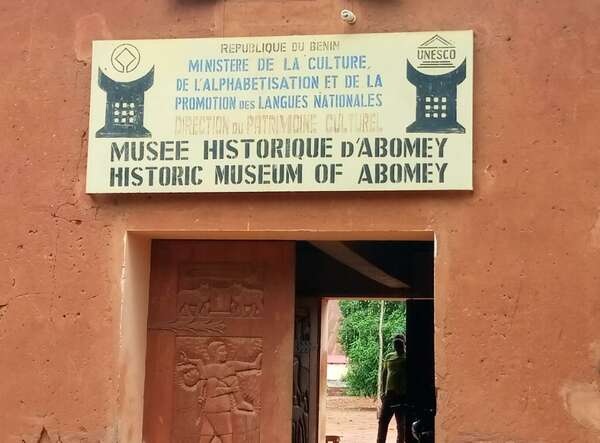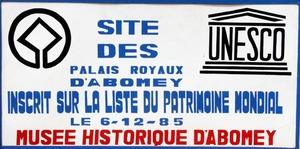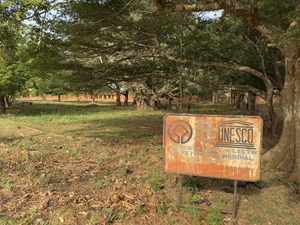Royal Palaces of Abomey

The Royal Palaces of Abomey testify to the power of those who ruled the Kingdom of Dahomey, one of the most powerful in West Africa.
The site consists of a number of former palaces (one for each successive king) within the same enclosure in the center of Abomey and one palace a few km’s away. These palaces were the political centers of their time and also stored the treasures of the kingdom. They were made with traditional earthen materials and decorated with polychrome bas-reliefs.
Community Perspective: inside the complex, you will find the best polychrome bas-reliefs. The tombs and museum are also interesting to visit. Solivagant’s review tells more about the history of the Fon of Dahomey.

Map of Royal Palaces of Abomey
Community Reviews
Christravelblog

The Royal Palaces of Abomey certainly were a highlight of my road trip in Benin. I did read about the "no photo" policy but with the help of a few Benin Francs that policy was abandoned very fast. Not with a big camera but with the iPhone I was allowed. Perfect, as the phones make good photos anyway these days.
The palaces are well restored (late 2019) and still some reconstruction was going on. Mainly restoring of the tatched roofs. A visit gives a good look into the Africa before the Europeans came. The tombs are also interesting to visit. The museum has relics from all the kings on display and also shows the history of the kingdoms. There are actually still kings in Benin today but, except some rule over the local community, they have not much to say.
The site is easily combined with a visit to the subterrean housing about 45 minutes away (Village souterrain d'Agongointo-Zoungoudo). A day trip from Cotonou can easily be arranged.
Read more from Christravelblog here.
Solivagant

This site provides a sense of the scale and nature of some West African Kingdoms prior to colonial rule. Forget any Europe or Asia-based preconceptions about what the word “Palace” implies and you could find a visit an interesting entree to the region’s history.
What remains is a large complex of 2 palaces – those of the 19th century Kings Ghezo and Glélé who were the 9th and 10th kings of Dahomey (Another 10 palaces were destroyed during the French defeat of the monarchy in the 1890s). The complex consists of large interlinked courtyards each surrounded by rather ordinary single story mud-brick buildings with “tin roofs” (originally of course they would have been thatched) and contains also a few separated structures which were/are tombs and temples. The whole is contained within impressively high walls (legend has it that they were partly made from human blood). Many of the buildings now act as rooms for the National Museum and contain a reasonably interesting range of artefacts relating to the monarchy of Dahomey whose period of greatness spanned the 17th to the 19th centuries (A throne mounted on skulls is particularly memorable!).
The size and strength of the palaces reflects the fact that the Fon of Dahomey were powerful regionally and highly militaristic under an absolute monarchy which owned everything and everybody! The Kingdom had a regiment of all-female warriers – the “Dahomey Amazons”, whose supposed “savagery” was the stuff of French legend as partial justification for their African expansion. Their wealth originally derived significantly from the sale of slaves in which the Kingdom acted both as capturers (mainly, but not entirely from other tribes) and as middlemen for tribes further into the interior of Africa. These slaves were exported to the Americas (mainly Brazil in the 18th century) through nearby Ouidah (Itself a T List entry and well worth a visit). The African slave trade depended on a supply chain anchored by such willing local rulers who, given the opportunity of vast additional profits offered by trading with the relatively few Europeans present on the coast, extended the long-standing inter-African “slavery tradition”. The trade was gradually made illegal by the various European and American powers during the 19th century but continued in both local and overseas forms during the period represented by these palaces. King Glélé in fact favoured dealing with the French rather than the British (represented by Sir Richard Burton no less!) partly because they were less active in suppressing the slave trade and he maintained “traditional” slavery within his kingdom particularly to support the new source of wealth - palm oil production and trade which depended on slave labour .
In some respects the visit can be a bit disappointing. We were there on market day and discovered that the interior of King Glélé’s tomb was closed because a “current princess” comes on that day to clean it (some descendents of the royal dynasty still live in parts of the complex)! More annoyingly, NO photography of any kind is allowed inside the compound. Whilst this is perfectly reasonable for the museum room interiors, we were told by our guide that it was to protect the postcard rights and that UNESCO officials had indeed criticised the rule. Yet, when we reached the museum shop, there were NO postcards or brochures on sale – nor any sign that they had been in the recent past! This “shop area” also has a “working” blacksmith and weaving to contribute to the site’s “tourism credentials” – but there were very few other tourists around during our visit.
The main “glory” of the courtyards is a series of 50 polychrome bas-reliefs of traditional significance on the walls of the “Adjalala” of King Glélé. A few, less good (and entirely modern?), are available to be photographed on the exterior walls, but it is inside the complex where the finest ones have been recently restored with financial and technical help from the Getty Conservation Institute. Their site (http://www.getty.edu/conservation/field_projects/abomey/ ) contains a 4.5 minute video, and much else, on the palaces. However the complex itself remains on the list of UNESCO sites in danger. The ravages of time and lack of money, together with a disastrous cyclone in 1984 have all contributed. My “combined photo” is made up of one my own of a crumbling exterior wall and buildings, together with another of some of the bas-reliefs scanned from “Masterworks of Man and Nature – Preserving our World Heritage” (Harper-Macrae ISBN 0-646-05376-0).
Site Info
Site History
2007 Removed from Danger list
Completed almost all corrective measures
1985 In Danger
considerable damage caused by the 1984 tornado
1985 Inscribed
Site Links
Unesco Website
Official Website
Related
In the News
Connections
The site has 21 connections
Art and Architecture
Constructions
Damaged
History
Human Activity
Individual People
Timeline
Trivia
Visiting conditions
WHS on Other Lists
World Heritage Process
Visitors
47 Community Members have visited.
The Plaque
 (external source)
(external source) (photo by Solivagant)
(photo by Solivagant) (photo by Bram de Bruin)
(photo by Bram de Bruin)